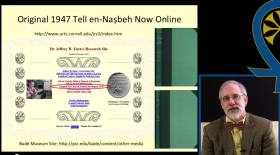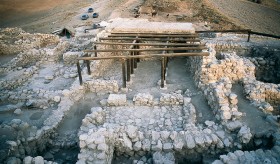Bin There, Done That: Storage Bins at Tell en-Nasbeh and the Role of the State
At theASOR Annual Meeting, Jeffrey Zorn of Cornell University presented his paper, “Bin There, Done That: Storage Bins at Tell en-Nasbeh and the Role of the State,” during the Archaeology of […]
David’s Jerusalem
By: Daniel Pioske In a letter sent to Charlemagne sometime just prior to 800 CE, Alcuin of York praised his “David,” as Charlemagne wished to be called later in life, for the benevolence with which he “ruled and governed” over Jerusalem. In truth, Charlemagne’s influence in Jerusalem was restricted to sponsorship of a few […]
The Land Between the Two Rivers: Early Israelite Identities in Transjordan
By: Thomas Petter, Associate Professor at Gordon-Conwell Theological Seminary Were there Israelites in Transjordan in the early Iron Age? How would we know from archaeology? Or if not Israelites (and Moabites), whom should we be looking for? The task of plotting identities in the past is tricky business. It becomes even more problematic when opinions diverge […]
Egyptian and Egyptianized Material in Late Bronze Age Canaan: An Examination of Cultural Identity
By: Krystal V.L. Pierce, University of California, Los Angeles Educational and Cultural Affairs Fellow W.F. Albright Institute of Archaeological Research The research I was able to conduct while in residence at the Albright resulted in the completion of my Ph.D. dissertation at UCLA entitled, Living and Dying Abroad: Aspects of Egyptian Cultural Identity in […]
Archaeology for the Masses: Tearing Down the Barriers between Archaeology and the Public
By: Itzick Shai and Joe Uziel Who does archaeology belong to – the few or the many? Sitting in our archaeology labs we often find ourselves delving into small details uncovered in excavations. These questions of how past societies lived, interacted and functioned often seem of little importance to the wider public, which usually takes […]
Tel Hazor Iron I and Iron IIa Ages Photo Gallery
Photo Gallery: Here’s a gallery of all the images that appear in Near Eastern Archaeology 76.2 for Hazor in the Iron I and Iron IIa Ages. Smaller versions of some of the images also appear in the article “Hazor in the Tenth Century BCE” on the ASOR Blog / ANE Today which you can read here. […]
Hazor in the Tenth Century BCE
ANE Today Editorial Introduction:* Few topics are more controversial than the biblical kingdoms of David and Solomon. Were they and their rulers real, and if so, what archaeological remains did they leave? Or were they literary creations, exaggerations or even fabrications of later biblical writers? The arguments have raged for almost three decades without end, […]
The Renewed Hazor Excavations
By: Amnon Ben-Tor, The Hebrew University of Jerusalem Edited and abridged from NEA 76.2: 66–67 (see editorial note below) Tel Hazor, “the head of all those kingdoms” (Joshua 11:10), is the largest tell in Israel and encompasses a total of approximately 800 dunams (200 acres). With the exception of two gaps in the settlement, […]
The Virtual World Project: Touring The Ancient World
By: Ronald A. Simkins and Nicolae Roddy, Creighton University There is nothing quite like teaching at an archaeological site, where ancient remains almost speak out to students as witnesses of the past. Both authors have led study tours in Israel, taking students to archaeological sites like Tel Dan, Bethsaida, Megiddo, Arad, Beer-sheba, and others, lecturing […]
A Monumental Surprise in Turkey
By: Dylan Johnson Heritage Fellow ASOR’s Heritage Fellowship afforded me, along with many other students with an interest in Near Eastern archaeology, the opportunity to participate in archaeological excavations throughout the Near East. This past summer, I worked at Tell Taʾyinat, a small site in the southwestern province of Hatay, Turkey, close to the […]
Geographical Factors in the Defense of Judah and Israel
By: Kyle Keimer, University of California, Los Angeles, Educational and Cultural Affairs Fellow My research focused on describing the varying strategies for defense of Israel and Judah in light of each kingdom’s topographical realities and the changing political situation over the course of the Iron II. I began with two basic questions: 1) how, in […]
Metal Implements and Tool Marks from the Levantine Second Millennium BC
By: Nicholas Blackwell, Bryn Mawr College, American School of Classical Studies at Athens, AIAR Educational and Cultural Affairs Fellow The primary purpose of my Springfellowship at the Albright Institute was to compile an extensive dataset of metal tools from the Levantine second millennium BC. This research began to round out the previously-incomplete Levantine […]
The Tel Burna Archaeological Project
By: Joe Uziel, Israel Antiquities Authority, Ernest S. Frerichs Fellow In, Dr. Itzhaq Shai and I initiated a long-term archaeological project at Tel Burna. The site is located in the Judean Shephelah on the northern banks of Wadi Guvrin. While described by a number of scholars over the years as a prominent ancient site, […]
The Philistine Remains at Tell es-Safi/Gath: Their Regional and Transcultural Connections with the Aegean and Cyprus
EnglishEnglishFrenchPowered by TranslateBy: Louise Hitchcock, University of Melbourne, National Endowment for the Humanities Fellow My sabbatical semester at the Albright resulted in a preliminary analysis of the stratigraphy, finds, and architecture from Area A2, in the early Philistine sector of Tell es-Safi/Gath, in collaboration with Prof. Aren Maeir and specialist members of the excavation team. […]
Basalt Connections at Zincirli Hoyuk
By: Leann Pace and Eudora Struble When Eudora and I began graduate school together at the University of Chicago, I don’t believe either of us was planning to work on a long-term archaeological project in Turkey. Eudora was very involved with archaeology in Jordan and my limited experience led me to believe that I wanted […]
10th Century BCE Hebrew Inscription Found at Khirbet Qeiyafa
Contributed by Y. Garfinkel (November 5) This summer an extraordinary Semitic inscription was found at Khirbet Qeiyafa. It was uncovered inside the fortified city, near the gate, lying on a floor level of a building. The city existed for a rather short time, within the 10th century BC, thus, the dating of the inscription […]






